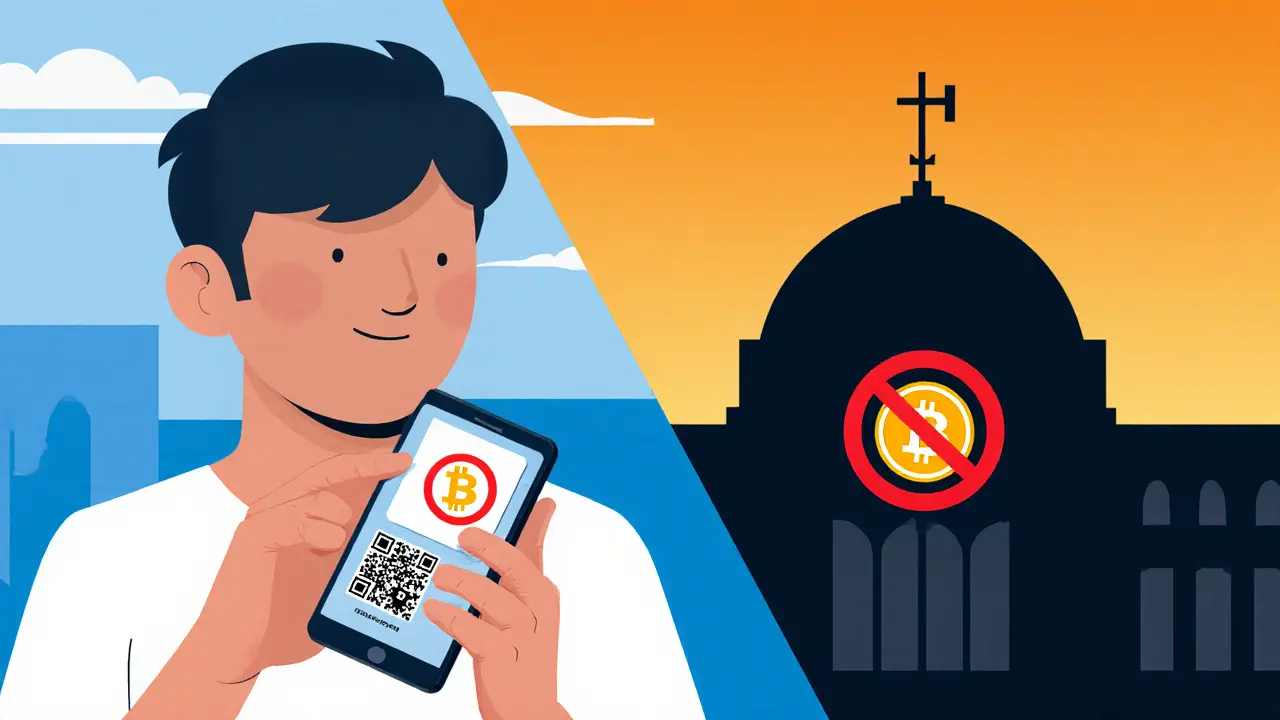Crypto Remittance Cost Calculator
Calculate Your Remittance Costs
Compare the real-world costs of sending money to Morocco using crypto versus traditional banking methods.
Cost Breakdown
Key Comparison
Traditional: 5-10% fee, 2-5 business days
Crypto (Stablecoins): ~0.5% fee, minutes to hours
CBDC (Future): ~0.2% fee, instant settlement (projected)
Morocco bans crypto on paper, but everyday people still find ways to move money across borders using digital coins. If you’ve ever wondered why a country can outlaw something yet see a booming underground market, this piece shows exactly how Moroccans turn to cryptocurrency for faster, cheaper remittances.
Key Takeaways
- Morocco’s 2017 ban pushes crypto activity underground, not off the grid.
- Bitcoin, Ethereum and stablecoins power most cross‑border payments.
- Bank Al‑Maghrib is developing a CBDC that could rival private crypto for international transfers.
- Risks include price volatility, lack of legal recourse, and exposure to fraud.
- Projected market size of $292million by 2026 signals lasting demand.
cryptocurrency Morocco is a digital‑asset ecosystem that thrives despite the official prohibition announced in November2017. The ban cites consumer‑protection gaps, money‑laundering concerns and foreign‑exchange violations, yet real‑world users keep the network alive.
Regulatory Landscape: The Official Ban
When the Ministry of Economy and Finance declared all crypto transactions illegal, it wasn’t just a warning-it was a legal line in the sand. The Central Bank of Morocco, Bank Al‑Maghrib, began issuing fines and monitoring exchanges, but it never shut down the internet. The paradox is clear: the state wants to control capital flows, while citizens crave a way to send money to family in Europe, the U.S., or the Gulf.
Underground Networks: How Bitcoin and Friends Slip Through
In practice, Moroccans rely on peer‑to‑peer platforms, encrypted messaging apps and overseas crypto‑exchange accounts. The most common entry point is Bitcoin, the original decentralized coin. Users buy Bitcoin on foreign platforms, store it in mobile wallets, and then send it to a contact abroad. The recipient swaps it for local currency through a trusted agent, often a shop that handles cash‑in‑cash‑out for the diaspora.
Ethereum plays a similar role, especially for merchants who accept stablecoins pegged to the U.S. dollar. Stablecoins sidestep Bitcoin’s wild price swings and let sellers price goods in a familiar currency while still benefiting from blockchain speed.
Step‑by‑Step: Sending Money Across Borders with Crypto
- Choose a reputable foreign exchange - often a platform based in Europe or the U.S.
- Buy the desired crypto (Bitcoin, Ethereum, or a stablecoin) using a bank card or cash‑deposit service.
- Open a mobile wallet app that supports QR‑code scanning.
- Enter the recipient’s wallet address, double‑check the amount, and confirm the transaction.
- The blockchain validates the transfer (usually within minutes for Bitcoin, seconds for stablecoins).
- The recipient’s local agent converts the crypto back to Moroccan dirhams (MAD) and hands over cash.
Each step leaves a digital trail on the blockchain, which is immutable and transparent - a double‑edged sword. It protects both parties from chargebacks, but it also means authorities can trace activity if they bother to look.
Why Crypto Beats Traditional Remittance Channels
Bank transfers to Europe can cost 5‑10% and take several days. Money‑transfer operators charge similar fees, plus hidden exchange‑rate margins. Crypto slashes the cost to under 1% and settles in minutes, a huge advantage for a country where many families depend on remittances from abroad.
Central Bank Digital Currency (CBDC): The State’s Counter‑Offer
While the ban stays, Bank Al‑Maghrib is quietly building a national digital currency focused on peer‑to‑peer and cross‑border payments. Governor Abdellatif Jouahri says the CBDC will be issued and managed by the central bank, offering the speed of blockchain without the volatility of Bitcoin.
The CBDC prototype is being tested with the International Monetary Fund and the World Bank. These partnerships aim to create a shared digital‑payment corridor across North Africa, linking Morocco with Egypt and beyond.
Technical Edge: What Makes Blockchain Attractive?
Three technical reasons keep crypto in demand:
- Decentralized access: Anyone with a smartphone and internet can join, no need for a local bank account.
- Immutable ledger: Once confirmed, a transaction can’t be reversed, eliminating chargeback fraud.
- Predictable settlement: Blockchain timestamps provide a clear record for both sender and receiver.
These benefits directly address the pain points of the formal banking system, which often stalls payments due to foreign‑exchange controls.
Risks and Consumer‑Protection Gaps
Bank Al‑Maghrib warns that crypto users face major hazards: price swings, platform hacks, and total lack of legal recourse. If a wallet is compromised, there’s no insurance or regulator to turn to. Moreover, because the market operates underground, users rely heavily on personal trust networks, which can be exploited.
To mitigate risk, savvy Moroccans stick to stablecoins for remittances, keep transaction sizes small, and use reputable agents who have built a track record over years.

Market Outlook: Numbers That Matter
Industry analysts project Morocco’s crypto market to reach $278.7million in 2025 and $292.4million by 2026. The growth is driven by a diaspora that sends roughly $1.5billion annually back home. Even a modest shift of 2% of that flow to crypto translates into a multi‑million‑dollar ecosystem.
On July212025, the central bank unveiled a draft law to legalize and regulate certain crypto activities. If passed, the law could create a licensing framework for exchanges, offering users some protection while preserving the state’s control over capital.
Comparison: Crypto vs. Proposed CBDC vs. Traditional Remittance
| Feature | Bitcoin / Stablecoins | Proposed CBDC | Bank Transfer / Money‑transfer operators |
|---|---|---|---|
| Regulation | Prohibited, underground | Government‑approved, regulated | Fully regulated |
| Cost (per $100) | ≈0.5% (incl. network fee) | ≈0.2% (state‑set fee) | 5‑10% |
| Speed | Minutes‑to‑hours | Instant (on‑chain settlement) | 2‑5 business days |
| Volatility | High (BTC) / Low (stablecoins) | None (pegged to MAD) | None |
| Consumer protection | None (risk of loss) | State‑backed recourse | Bank guarantees |
The table shows why many Moroccans still favor private crypto despite the ban: cost and speed win hands down. If the CBDC rolls out as promised, it could capture a sizable share of the market, especially among risk‑averse users.
Practical Tips for Moroccan Crypto Users
- Use stablecoins (USDC, USDT) for remittances to dodge Bitcoin’s price swings.
- Keep private keys offline when not actively sending funds.
- Choose exchange partners with strong KYC practices - they’re less likely to be shut down.
- Stay updated on the draft law; a licensing regime could open up new, safer services.
- Consider mixing crypto with the future CBDC - once launched, you’ll be able to move funds between the two ecosystems.
Frequently Asked Questions
Is using Bitcoin illegal in Morocco?
Yes, the Ministry of Economy and Finance declared all cryptocurrency transactions illegal in November2017. However, enforcement focuses on exchanges, not on individual peer‑to‑peer transfers, so many users still operate under the radar.
What’s the biggest advantage of stablecoins over Bitcoin for sending money?
Stablecoins are pegged to a fiat currency, usually the U.S. dollar, so their value doesn’t swing wildly. That means the amount the recipient receives stays predictable, unlike Bitcoin which can change 5‑10% in a few hours.
When might Morocco’s CBDC become available?
Bank Al‑Maghrib announced a pilot in early 2024 and said a full rollout could happen by 2026, depending on regulatory approvals and the outcome of the draft law.
Are there any legal protections if my crypto wallet is hacked?
No. Because cryptocurrency use is prohibited, there’s no consumer‑protection framework. If you lose funds, you have no recourse through banks or regulators.
How does the diaspora benefit from crypto remittances?
Diaspora members can send money directly from abroad without waiting for bank processing or paying high fees. Recipients get cash faster, which is crucial for daily expenses and emergencies.
In short, Moroccan crypto users have built a resilient, tech‑savvy work‑around to the official ban. Whether the upcoming CBDC will replace private coins or simply coexist remains to be seen, but the demand for cheap, instant cross‑border payments won’t disappear overnight.


10 Responses
Wow, because nothing says patriotism like sending dollars across the ocean with a blockchain, right? 😏!!!
Sure, crypto is the magic bullet for every remittance problem-if you ignore the volatility.
Crypto remittance is like a neon unicorn riding a rollercoaster-glittery, loud, and kinda pointless
I get why folks love the speed, but remember there’s still a human side-family members counting on those dirhams.
It’s amazing how a stable‑coin can pop money into a Moroccan bank in minutes-so dramatic, isn’t it?
Look, if you want to keep the money flowing fast, crypto is the bridge-but don’t forget the little fees that hide under the hood.
While the hype is loud, the reality is a bit more nuanced-network congestion can still bite.
Indeed, one must consider the macro‑economic implications of a mass migration toward digital assets; the traditional banking sector cannot simply observe without strategic recalibration. Moreover, regulatory frameworks across jurisdictions remain in flux, which may introduce compliance complexities for both senders and receivers. Hence, the enthusiasm should be tempered with prudent risk assessment.
Crypto isn’t just a tech fad; it’s a geopolitical lever that can shift power balances, especially in regions reliant on remittances.
yOu shOuld alSo check tha t the excha nge ratE is fAir; iT can chAnge when you rEAlly neEd the cash.